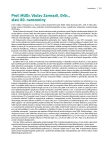Central Thyroid Disorders
Authors:
Michal Kršek
Authors‘ workplace:
II. interní klinika 3. LF UK a FN Královské Vinohrady, Praha
Published in:
Vnitř Lék 2016; 62(Suppl 3): 82-86
Category:
Reviews
Overview
Vast majority of thyroid function disturbances have primary (peripheral) etiology due to thyroid gland disorders. Rarely, dysfunction of central regulatory structures, hypothalamus and pituitary, can be a cause of both, hyperthyroidism and hypothyroidism. Despite being very rare, it is important to be aware of them not to misdiagnose their etiology. Early and correct etiological diagnosis is necessary for proper cure and decrease of morbidity and mortality of affected patients. Present review article summarizes basics and specific features of central disturbances of thyroid function, their clinical signs, diagnosis, differential diagnosis and treatment.
Key words:
hypothalamus – hyperthyroidism – hypothyroidism – pituitary – thyrotropinoma
Sources
1. Jailer JW, Holub DA. Remission of Graves‘ disease following radiotherapy of a pituitary neoplasm. Am J Med 1960; 28 : 497–500.
2. Hamilton CR Jr, Adams LC, Maloof F. Hyperthyroidism due to thyrotropin-producing pituitary chromophobe adenoma. N Engl J Med 1970; 283(20): 1077–1080.
3. Beck-Peccoz P, Brucker-Davis F, Persani L et al. Thyrotropin-secreting pituitary tumors. Endocr Rev 1996; 17(6): 610–638.
4. Önnestam L, Berinder K, Burman P et al. National incidence and prevalence of TSH-secreting pituitary adenomas in Sweden. J Clin Endocrinol Metab 2013; 98(2): 626–635. Dostupné z DOI: <http://dx.doi.org/10.1210/jc.2012–3362>.
5. Beck-Peccoz P, Persani L, Mannavola D et al. Pituitary tumours: TSH-secreting adenomas. Best Pract Res Clin Endocrinol Metab 2009; 23(5): 597–606. Dostupné z DOI: <http://dx.doi.org/10.1016/j.beem.2009.05.006>.
6. Socin HV, Chanson P, Delemer B et al. The changing spectrum of TSH-secreting pituitary adenomas: diagnosis and management in 43 patients. Eur J Endocrinol 2003; 148(4): 433–442.
7. Abs R, Stevenaert A, Beckers A. Autonomously functioning thyroid nodules in a patient with thyrotropin secreting pituitary adenoma: possible cause-effect relationship. Eur J Endocrinol 1994; 131(4): 355–358.
8. Hana V, Seidl Z, Vaneckova M et al. Randomly discovered enlargement in the region of sella turcica. Vnitř Lék 2007; 53(7–8): 816–820.
9. Webster J, Peters JR, John R et al. Pituitary stone: two cases of densely calcified thyrotropin-secreting pituitary adenomas. Clin Endocrinol (Oxf) 1994; 40(1): 137–143.
10. Beck-Peccoz P, Persani L. Variable biological activity of thyroid-stimulating hormone. Eur J Endocrinol 1994; 131(4): 331–340.
11. Dumitrescu AM, Retetoff S. The syndromes of reduced sensitivity to thyroid hormone. Biochim Biophys Acta 2013; 1830(7): 3987–4003. Dostupné z DOI: <http://dx.doi.org/10.1016/j.bbagen.2012.08.005>.
12. Beck-Peccoz P, Persani L, Lania A. Thyrotropin secreting pituitary adenomas. In: De Groot LJ, Beck-Peccoz P, Chrousos G et al (eds). Endotext (Internet). South Darmot MA, USA, MD Text.com. Inc., 2000. Dostupné z WWW: http://www.ncbi.nlm.nih.gov/books/NBK278943.
13. Losa M, Mortini P, Franzin A et al. Surgical management of thyrotropin-secreting pituitary adenomas. Pituitary 1999; 2(2): 127–131.
14. Mannavola D, Persani L, Vannucchi G et al. Different responses to chronic somatostatin analogues in patients with central hyperthyroidism. Clin Endocrinol (Oxf) 2005; 62(2): 176–181.
15. Lania A, Persani L, Beck-Peccoz P. Central hypothyroidism. Pituitary 2008; 11(2): 181–186. Dostupné z DOI: <http://dx.doi.org/10.1007/s11102–008–0122–6>.
16. Sherman SI, Gopal J, Haugen BR et al. Central hypothyroidism associated with retinoid X receptor-selective ligands. N Engl J Med 1999; 340(14): 1075–1079.
17. Dattani MT, Robinson IC. The molecular basis for developmental disorders of the pituitary gland. Clin Genet 2000; 57(5): 337–346.
18. Cohen LE, Radovick S. Molecular basis of combined pituitary hormone deficiencies. Endocr Rev 2002; 23(4): 431–442.
19. Baloch Z, Carayon P, Conte-Devolx B et al. Laboratory medicine practice guidelines. Laboratory support for the diagnosis and monitoring of thyroid disease. Thyroid 2003; 13(1): 3–126.
20. Mehta A, Hindmarsh PC, Stanhope RG et al. Is the thyrotropin-releasing hormone test necessary in the diagnosis of central hypothyroidism in children. J Clin Endocriol Metab 2003; 88(12): 5696–5703.
Labels
Diabetology Endocrinology Internal medicineArticle was published in
Internal Medicine

2016 Issue Suppl 3
Most read in this issue
- Congenital Adrenal Hyperplasia in Adults
- Multiple Endocrine Neoplasia I (Wermer‘s Syndrome), Forms of Clinical Manifestation, 5 Case Studies
- Vitamin D and autoimmune thyroid diseases
- Central Thyroid Disorders
